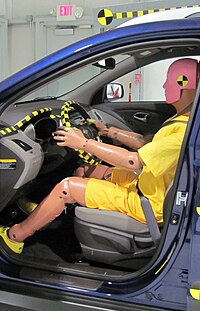
Photo from wikipedia
Vehicle platooning has been proposed as one of the potential technologies for intelligent transport systems to improve transportation and energy efficiency in urban cities. Despite extensive studies conducted on the… Click to show full abstract
Vehicle platooning has been proposed as one of the potential technologies for intelligent transport systems to improve transportation and energy efficiency in urban cities. Despite extensive studies conducted on the platooning of heavy-duty trucks, literature on the analysis of urban vehicle platoons has been limited. To analyse the impact of platooning in urban environments, this paper studies the influence of intervehicle distance, platoon size and vehicle speed on the drag coefficient of the vehicles in a platoon using computational fluid dynamics (CFD). Two vehicle models—a minibus and a passenger car—are analysed to characterise the drag coefficients of the respective platoons. An analysis of energy consumption is conducted to evaluate the energy savings with platooning using a longitudinal dynamics simulation. The results showed a reduction in the average drag coefficient of the platoon of up to 24% at an intervehicle distance of 1 m depending on the number of vehicles in the platoon. With a larger intervehicle distance of 4 m, the reduction in the drag coefficient decreased to 4% of the drag coefficient of the isolated vehicle. Subsequently, energy savings with platooning were calculated to be up to 10% depending on the driving cycle, intervehicle distance and platoon size.
Journal Title: Energies
Year Published: 2020
Link to full text (if available)
Share on Social Media: Sign Up to like & get
recommendations!